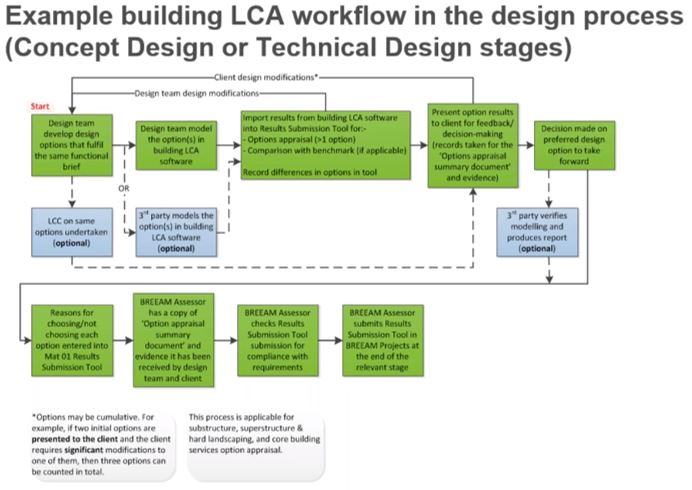BREEAM UK New Construction 2018 changes summary
Contents |
[edit] Introduction
This is a simple summary of the main changes only from a working assessor
[edit] Related resources
[edit] Management
[edit] Man03 – Responsible Construction Practices:
- The BREEAM AP will have a deeper involvement in evidence collation and monitoring on site
- The Considerate Constructors Scheme is no longer the only way to achieve this credit and further actions and evidence will need to be provided – see separate guidance notes
- Targets are now required for the water consumption, energy and transportation CO2 emissions during construction
[edit] Man04 – Commissioning and Handover: (n/a to shell assessments)
- Exemplary credit removed for monitoring energy and water consumption for 3years after occupation.
- Separate guides now required for the building users and the facilities management.
[edit] Health and Wellbeing
[edit] Hea01 – Visual Comfort :
- A Glare Control Assessment is now required to demonstrate areas where glare will and will not be an issue. The client may need to include for blinds as part of the base building. The specification of compliant blinds to all relevant spaces will negate the need for a Glare Control Assessment. (n/a to shell or shell and core assessments)
[edit] Hea02 – Indoor Air Quality :
- An Indoor Air Quality Plan (IAQ) is now a pre-requisite rather than a credit and must be completed at RIBA Stage 2. This should be commissioned on all projects pre-planning. (n/a to shell assessments)
- View Out is now assessed on 95% of floor area to 95% of spaces for relevant building areas as opposed to the previous requirements for 100% compliance. (n/a to shell assessments)
- Updated standards for VOC and formaldehyde targets. 2 credits are now available based upon the number of products which comply. Architects should reference the new standards in their specifications and ensure the specification of compliant paints and finishes. (n/a to shell or shell and core assessments)
[edit] Hea06 – Security :
- Safe Access has been relocated to Hea07. Security Specialist definition amended.
[edit] Hea07 – Safe Access and Healthy Surroundings :
- Safe Access credit has been relocated from Hea06.
- An outside space as an amenity must be provided for building users/staff.
[edit] Energy
[edit] Ene01 – Reduction of Energy Use and Carbon Emissions :
- Scoring has been updated and benchmarks raised from 2014. A minimum of 4 credits are required for an excellent.
- 4 credits are now available for Prediction of Operational Energy Consumption. A pre-requisite requires an energy strategy workshop at Stage 2. To gain the credits additional energy modelling is required at design and post construction stages (n/a to shell assessments)
[edit] Ene03 – External Lighting :
- Minimum luminous efficacy requirements have been raised to 70 luminaire lumens per circuit watt (previously 60)
[edit] Ene08 – Energy Efficient Equipment : (n/a to shell or shell and core assessments)
- Small power has been removed as an entry in the examples of solutions table to reflect it may not be installed as part of the project works and rather will be a tenant fit out item.
- Where there is no unregulated energy consuming equipment being installed, the credit can now be filtered out.
[edit] Transport
[edit] Tra01 – Transport Assessment and Travel Plan :
- Travel Plan requirements from Tra05 have been relocated to Tra01. The travel plan must include information on the site’s Accessibility Index and Proximity to Amenities (formerly issues Tra01 and Tra02).
[edit] Tra02 – Sustainable Transport Measures:
- New issue which incorporates the requirements of Tra03 and 04.
- 10 credits are available dependant on the number of points scored. Number of points required is related to the Accessibility Index i.e. more sustainable transport measures will be required where there are poor transport links
- Points are awarded based on how many of the sustainable transport measures have been followed/implemented within the scheme. London sites will generally need to score 6-8 points to gain the full 10 credits.
- Point scoring system and options are set out in the table 7.4. (Author suggestion for the measures which should be targeted, and these will give 8 points for full credits in London generally are 1, 3, 4, 7, 8, 9 and 10.
[edit] Materials
[edit] Mat01 – Environmental Impacts from Construction Products - LCA :
- The issue has substantially changed and now incorporates the previous Mat02 (hard landscaping and boundary protection) and Mat04 (insulation) issues. Credits are no longer awarded using green guide ratings but on a Life Cycle Analysis of the building using either a simplified BREEAM tool or IMPACT compliant software. The score is significantly capped where just the simplified tool is used to a maximum of 2 out of 7. Therefore, a full LCA is advised using an Impact compliant software tool. Where using the simplified at Concept Design and full LCA software at Technical Design a maximum of 4 credits can be achieved.
- Life cycle analysis of the building should start at Concept Design and include appraisals for various design options at both Concept and Technical Design to inform the final design. To be submitted to the BRE at the end of Stage 2 and 4.
- Points are awarded (maximum of 2) based on the building’s performance against a benchmark building. It should be noted that the two credits may be hard to achieve based on a building of concrete construction.
- The life cycle analysis will need to be updated during the Technical Design stage.
- If the initial life cycle analysis is not completed and submitted to the BRE at Stage 2, only 3 of the 7 credits can be targeted for this issue.
- The simplified BREEAM tool can not be used at Technical Design Stage.
[edit] Mat02 – Environmental Impacts from Construction Products - EPD:
- Mat02 now focuses on encouraging the specification of products with Environmental Product Declarations (EPDs). Architect’s will need to be made aware of the new criteria. Points are awarded based on the type of EPD a product has and a total of 20 points is required to achieve a credit over 10 product categories:
- A maximum of 4 points can be achieved under each category, although there are no weightings or restrictions placed on the amount or volume of materials specified with EPDs, which could be exploited.
[edit] Mat03 – Responsible Sourcing of Materials:
- The Sustainable Procurement Plan must be prepared at RIBA Stage 1.
- The responsible sourcing benchmarks have been reduced and building services is now an exemplary performance issue. Therefore, it should now be easier to achieve more credits, at least 2, for this issue.
[edit] Waste
[edit] Wst01 – Construction Site Waste Management:
- The pre-demolition audit is now a separate credit and must be completed at Stage 2. Requirements are now more stringent.
[edit] Wst02 – Use of Recycled and Sustainably Sourced Aggregates:
- The way this issue is assessed and scored has been changed radically. Points are calculated based on aggregate type, amount, distance travelled and region aggregate was located.
[edit] Wst06 – Design for Disassembly and Adaptability:
- This issue is now split into 2 credits – one for recommendations (Stage 1-2) and one for Implementation (Stage 4). Additional focus on disassembly.
[edit] Land Use and Ecology
[edit] LE02- LE05 :
- The ecology section has been completely rewritten. An ecological site survey and evaluation must be completed at Stage 1 for any credits to be awarded. Where there is little or no ecology, an ecologist is not necessarily required (a checklist needs to be completed to see if Route 1 (no ecologist) can be adopted). However, the amount of credits that can be achieved using Route 1 is capped to 5, out of a possible 11 where Route 2 is adopted (using an ecologist).
- The ecologist must be involved and collaborate with the design team during the Concept Design to optimise the ecological value of the site and the scope for limiting negative impacts and maximising the enhancement opportunities.
[edit] Pollution
[edit] Pol02 – Local Air Quality
- NOx, VOCs and particulate matters are now assessed and benchmarks for the NOx emissions have been revised dependant on the heating and hot water system being installed
[edit] Pol03 – Flood and Surface Water Management :
- There is now a requirement for a 30% reduction in surface water run-off for brownfield sites (still set at no change for greenfield sites)
BRE Global does not endorse any of the content posted and use of the content will not guarantee the meeting of certification criteria.
--Jane Morning 17:02, 16 Jul 2018 (BST)
Featured articles and news
RTPI leader to become new CIOB Chief Executive Officer
Dr Victoria Hills MRTPI, FICE to take over after Caroline Gumble’s departure.
Social and affordable housing, a long term plan for delivery
The “Delivering a Decade of Renewal for Social and Affordable Housing” strategy sets out future path.
A change to adoptive architecture
Effects of global weather warming on architectural detailing, material choice and human interaction.
The proposed publicly owned and backed subsidiary of Homes England, to facilitate new homes.
How big is the problem and what can we do to mitigate the effects?
Overheating guidance and tools for building designers
A number of cool guides to help with the heat.
The UK's Modern Industrial Strategy: A 10 year plan
Previous consultation criticism, current key elements and general support with some persisting reservations.
Building Safety Regulator reforms
New roles, new staff and a new fast track service pave the way for a single construction regulator.
Architectural Technologist CPDs and Communications
CIAT CPD… and how you can do it!
Cooling centres and cool spaces
Managing extreme heat in cities by directing the public to places for heat stress relief and water sources.
Winter gardens: A brief history and warm variations
Extending the season with glass in different forms and terms.
Restoring Great Yarmouth's Winter Gardens
Transforming one of the least sustainable constructions imaginable.
Construction Skills Mission Board launch sector drive
Newly formed government and industry collaboration set strategy for recruiting an additional 100,000 construction workers a year.
New Architects Code comes into effect in September 2025
ARB Architects Code of Conduct and Practice available with ongoing consultation regarding guidance.
Welsh Skills Body (Medr) launches ambitious plan
The new skills body brings together funding and regulation of tertiary education and research for the devolved nation.
Paul Gandy FCIOB announced as next CIOB President
Former Tilbury Douglas CEO takes helm.
UK Infrastructure: A 10 Year Strategy. In brief with reactions
With the National Infrastructure and Service Transformation Authority (NISTA).
























